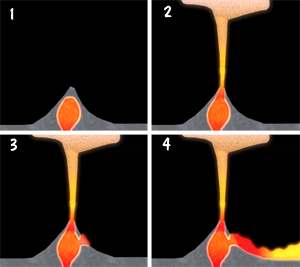In adesitic and rhyolitic magmas the gases have more difficulty escaping as the magma is far more viscous. As such the magma rises to a much higher level before beginning the gas release process, and it is far more energetic.
As the gas finally escapes it can form a froth called "pumice" which looks very much like a glass sponge. Pumice is so light it will float on water due to its closed cell structure and the entrapped gasses.
If there is even more gas present then the pumice is effective destroyed and turned into hot shards which produces "volcanic ash". The key moving force for explosive eruptions is the gas, no matter what the composition of a magma, it will flow smoothly if there is little gas.
|
(mm) |
|
|
|
|
|
|
|
|
|
|
|
|
|
|
|
|
|
Pyroclast is the general term that describes airborne fragments. Pyroclastic rocks are those formed from the fragments. This is also known as tephra. The projectiles have different names depending on their size.
Mt. Vesuvius in 79 A.D. and the destruction of Pompeii was such a blast.
At the beginning of the eruption the super hot gases literally tear themselves out of the magma churning it to ash. The hot fluid rises rapidly in the outside atmosphere forming a column of ash and debris. "eruption column" When it rises to the point where the density of the material in the column equals that of the surrounding atmosphere it fan out forming an anvil shaped cloud.
The wind then carries the material laterally over great distance as it slowly settles back to the earth. It can travel more than 1000 km in volume.
A "pyroclastic flow" is a rush of tephra moving down the sides of a volcano rather than upward. These are lethal eruptions. Typically they come from lateral vents on the sides of volcanoes. They can travel 100 km or more and have been measured at more than 700 km/hr. (> 400 mph) about the speed of commercial jet aircraft.
Pyroclastic flows can also be caused by the collapse of the original column due to gravity. The column at first moves upward, and then due to its own weight sinks rapidly back and spreads out over the flank of the volcano.

| NEXT | TOC | PREV |